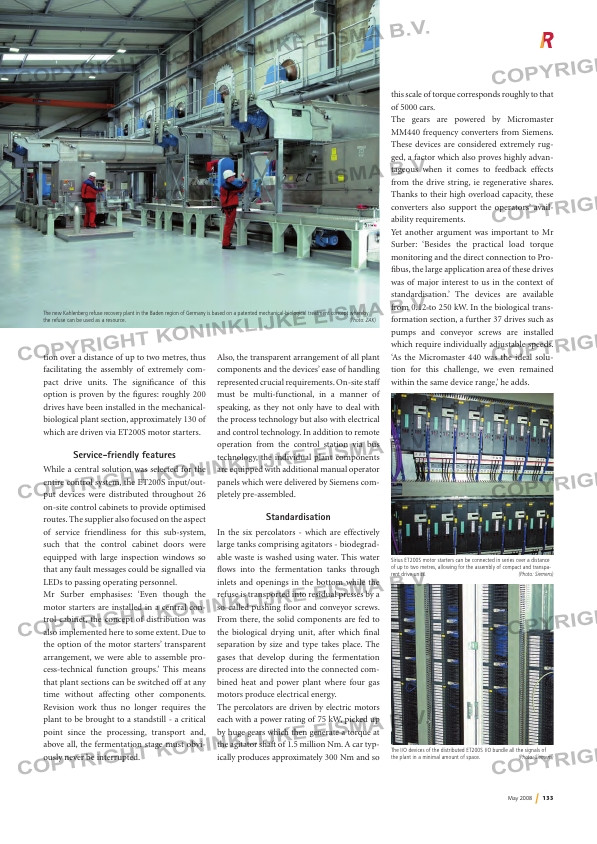Page 133 from: May 2008

May 2008 133
tion over a distance of up to two metres, thus
facilitating the assembly of extremely com-
pact drive units. The significance of this
option is proven by the figures: roughly 200
drives have been installed in the mechanical-
biological plant section, approximately 130 of
which are driven via ET200S motor starters.
Service-friendly features
While a central solution was selected for the
entire control system, the ET200S input/out-
put devices were distributed throughout 26
on-site control cabinets to provide optimised
routes. The supplier also focused on the aspect
of service friendliness for this sub-system,
such that the control cabinet doors were
equipped with large inspection windows so
that any fault messages could be signalled via
LEDs to passing operating personnel.
Mr Surber emphasises: ‘Even though the
motor starters are installed in a central con-
trol cabinet, the concept of distribution was
also implemented here to some extent. Due to
the option of the motor starters’ transparent
arrangement, we were able to assemble pro-
cess-technical function groups.’ This means
that plant sections can be switched off at any
time without affecting other components.
Revision work thus no longer requires the
plant to be brought to a standstill – a critical
point since the processing, transport and,
above all, the fermentation stage must obvi-
ously never be interrupted.
Also, the transparent arrangement of all plant
components and the devices’ ease of handling
represented crucial requirements. On-site staff
must be multi-functional, in a manner of
speaking, as they not only have to deal with
the process technology but also with electrical
and control technology. In addition to remote
operation from the control station via bus
technology, the individual plant components
are equipped with additional manual operator
panels which were delivered by Siemens com-
pletely pre-assembled.
Standardisation
In the six percolators – which are effectively
large tanks comprising agitators – biodegrad-
able waste is washed using water. This water
flows into the fermentation tanks through
inlets and openings in the bottom while the
refuse is transported into residual presses by a
so-called pushing floor and conveyor screws.
From there, the solid components are fed to
the biological drying unit, after which final
separation by size and type takes place. The
gases that develop during the fermentation
process are directed into the connected com-
bined heat and power plant where four gas
motors produce electrical energy.
The percolators are driven by electric motors
each with a power rating of 75 kW, picked up
by huge gears which then generate a torque at
the agitator shaft of 1.5 million Nm. A car typ-
ically produces approximately 300 Nm and so
this scale of torque corresponds roughly to that
of 5000 cars.
The gears are powered by Micromaster
MM440 frequency converters from Siemens.
These devices are considered extremely rug-
ged, a factor which also proves highly advan-
tageous when it comes to feedback effects
from the drive string, ie regenerative shares.
Thanks to their high overload capacity, these
converters also support the operators’ avail-
ability requirements.
Yet another argument was important to Mr
Surber: ‘Besides the practical load torque
monitoring and the direct connection to Pro-
fibus, the large application area of these drives
was of major interest to us in the context of
standardisation.’ The devices are available
from 0.12 to 250 kW. In the biological trans-
formation section, a further 37 drives such as
pumps and conveyor screws are installed
which require individually adjustable speeds.
‘As the Micromaster 440 was the ideal solu-
tion for this challenge, we even remained
within the same device range,’ he adds.
The new Kahlenberg refuse recovery plant in the Baden region of Germany is based on a patented mechanical-biological treatment concept whereby
the refuse can be used as a resource. (Photo: ZAK)
Sirius ET200S motor starters can be connected in series over a distance
of up to two metres, allowing for the assembly of compact and transpa-
rent drive units. (Photo: Siemens)
The I/O devices of the distributed ET200S I/O bundle all the signals of
the plant in a minimal amount of space. (Photo: Siemens)
RI_019_Waste processing.indd 3 14-05-2008 16:51:58



